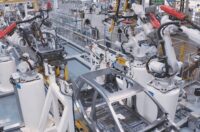EDINBURGH—China’s growing dominance in the electric vehicle market will threaten foreign brands and spark global debate in 2024, according to a recent report by energy research and consulting firm Wood Mackenzie. With EVs at the forefront of global geopolitics, the firm predicts this will be a pivotal year for electrification initiatives.
“With two-thirds of China’s power batteries produced in 2023 being iron-based, Chinese cell producers have capitalized on their expertise in low-cost chemistry,” says Max Reid, principal analyst for electric vehicles and battery supply chain at Wood Mackenzie. “This has allowed China to announce advancements in fast-charging and energy density improvements, putting foreign brands at risk of losing market share.
“China has wholeheartedly embraced EVs as part of its strategy to become a high-end manufacturing powerhouse,” explains Reid. “Unlike foreign brands, Chinese carmakers have prioritized enhancing in-vehicle software, a crucial factor for the average younger Chinese vehicle buyer. This shift not only threatens existing profit streams, but also endangers the future growth potential of foreign brands.”
According to Reid, automakers in Europe, North American and Southeast Asia may have a more cautious appetite for purchasing battery cells in 2024. “As cell prices decline, [they] will consider forgoing state subsidies tied to domestic manufacturing in favor of more affordable cells from China, thereby reducing overall EV costs. Non-Chinese Tier One cell manufacturers will seize this opportunity to explore lithium iron phosphate and lithium manganese iron phosphate cells, accommodating both cost-effective EV models and high-end models equipped with nickel-based batteries.”
Wood Mackenzie forecasts that surpluses of cobalt, graphite, lithium and nickel will continue for several years, providing relief to cell producers and alleviating concerns over rising materials costs. While the decrease in raw material costs provides some breathing room for midstream producers, such as anode, cathode and cell manufacturers, to expand margins and invest in research and development, it also presents an opportunity to gain market share in the Western EV market. As the industry aims to transition from early adopters to the mass market, the availability of low-cost EVs will be crucial.
“As the Chinese EV market continues to evolve, foreign automakers face a critical juncture in their strategic decision-making,” warns Reid. “Adapting to the unique demands of the Chinese consumer and forging partnerships with domestic innovators may prove pivotal in securing their position in this dynamic landscape.”
The contentious U.S. presidential election will also affect the electric vehicle industry in 2024. Campaign promises and policies surrounding EVs will be a major campaign point for leading candidates. Reid believes that Democrats will emphasize job growth benefits in the “battery belt” and reduced pollution-related deaths through EV adoption. In contrast, Republican candidates will argue against reduced purchasing freedom for consumers, while claiming that the uptick in EV purchases will indirectly benefit Chinese entities.
“Leading Republican candidates have made their intention to scrap the $7,500 federal EV subsidy and add an EV tax explicitly clear,” notes Prateek Biswas, a transport and materials analyst at Wood Mackenzie. “A rollback of the 2027-32 emission and fuel economy standards, combined with removed purchase subsidies, would not only pull back EV investments by the legacy auto sector, but also dent the profitability and future investment potential of global EV leaders like Tesla.”



